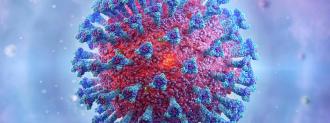To end the COVID-19 pandemic, we need to stop the virus from infecting new people — but right now, health experts are in fierce disagreement on how the coronavirus actually spreads.
The World Health Organization maintains that it spreads primarily through respiratory droplets. But is the coronavirus airborne, too? More than 200 scientists think it might be — and if they are right, it could change the global COVID-19 response.
Is the Coronavirus Airborne?
By now, the consensus opinion on how the coronavirus spreads is likely burned into your brain: a person with COVID-19 breathes, talks, coughs, or sneezes near someone else. Virus-carrying respiratory droplets leave their body, travel through the air, and if they don’t infect someone else, they fall to the ground after about 1-2 meters.
“Travel through the air” certainly sounds a lot like “airborne,” but they aren’t the same thing — at least not in scientific terms.
Aerosols can travel farther than droplets and remain aloft for hours.
If a virus is airborne, that means it can also travel through aerosols.
The only physical difference between aerosols and respiratory droplets is their size: droplets are 5 to 10 microns wide, like a fine mist from a spray bottle, and aerosols are less than 5 microns wide, more like dust motes. (A micron is equal to one millionth of a meter.)
Because aerosols are smaller than droplets, they can travel farther (up to several meters) when exhaled and remain aloft for hours before succumbing to gravity.
The highly contagious measles virus, for instance, is airborne: it can linger in the air for up to two hours after an infected person has left a room.
So, is the coronavirus airborne?
On July 6, over 230 scientists from 32 countries published an open letter to the WHO in the journal Clinical Infectious Diseases, arguing that the agency needs to address the possibility.
We think it has been transmitted this way all along.
Jose Jimenez
In the letter, the scientists cite several studies of SARS-CoV-2 and other respiratory infections that suggest the coronavirus must be able to travel through aerosols.
They say it’s the “only plausible explanation” for several superspreader incidents, during which a large number of people in one location caught the virus from a single infected person.
They argue that it is unlikely that all of the newly infected people (who sometimes number in the dozens to hundreds) could have come into close enough contact with the one superspreader to have contracted the virus through respiratory droplets alone.
“I have to do too many mental gymnastics to explain those other routes of transmission compared to aerosol transmission, which is much simpler,” letter co-author Linsey Marr told the New York Times.
Rethinking How the Coronavirus Spreads
WHO officials have said that the agency is reviewing the letter and will issue a summary about aerosol transmission in the coming days.
But does it really matter if the coronavirus can spread through aerosols?
In short, yes.
In the U.S., the CDC urges people to stay at least six feet away from others in public. That might be far enough to prevent you from catching a virus that spreads primarily through droplets, but it wouldn’t provide as much protection from one that also spreads via aerosols.
An airborne virus would be much more contagious in closed indoor spaces, like offices, factories, and restaurants, where the aerosol particles couldn’t disperse and might simply be recirculated through the air conditioning systems. (This could explain major superspreading events at places like meat-packing plants and call centers.)
If the WHO determines that COVID-19 can spread through aerosols, then, it could affect advice on social distancing and decisions about whether to resume office work.
It might also change governments’ decisions about things like reopening schools or restaurants — for example, they might decide to require certain levels of ventilation or filtration in buildings before allowing large numbers of people to gather inside.
The question of how the coronavirus spreads will likely affect healthcare workers throughout the world as well.
If COVID-19 is transmitted primarily through respiratory droplets, cloth masks are likely sufficient to prevent its spread, and those are what many healthcare workers currently wear. If it spreads through aerosols, though, they’ll need to upgrade to N95 masks to be adequately protected.
However, according to letter signatory Jose Jimenez, a chemist at the University of Colorado, this wouldn’t mean the coronavirus itself is suddenly a more formidable opponent.
“There is no reason for fear. It is not like the virus has changed. We think it has been transmitted this way all along,” he told the Washington Post. “Knowing about it helps target the measures to control the pandemic more accurately.”
We’d love to hear from you! If you have a comment about this article or if you have a tip for a future Freethink story, please email us at [email protected].






